The Mutant Project by Eben Kirksey

Author:Eben Kirksey
Language: eng
Format: epub
Publisher: St. Martin’s Press
* * *
An exhibit of future reproductive technologies on display in a huge atrium at the China National GeneBank illustrates scientific fantasies that have become surprisingly widespread. A blue-and-white canister mounted in a portable metal frame houses a translucent baby-sized plastic bag. The container sits on an exam table, and a robotic arm is poised as though ready to conduct an ultrasound exam. Pink baby flesh is visible inside the bag, with blurred outlines of a head, arms, and legs.
Nearby, a multimedia display in BGIâs main exhibit hall featured a looping video about âfuture applications of cell storage,â where scientific facts bled into fiction. A lamb fetus was moving inside an artificial womb, a clear plastic bag with tubes that act like an umbilical cord. One tube fed the developing creature with nutrientsâproteins, carbohydrates, and fatsâvia an intravenous drip. The baby lamb was also bathed in synthetic amniotic fluid. The fine print on this multimedia display indicated that the experimental work had been done elsewhere: the Childrenâs Hospital of Philadelphia (CHOP), where the experiments on Nicholas Wilkins and Emily Whitehead took place. Researchers at CHOP had incubated premature fetal lambs for four weeks until they were âborn.â
Rearing babies in artificial wombs has long been a dream of radical feminist thinkers. While many celebrated ânaturalâ childbirth, in the 1970s Shulamith Firestone openly called for a revolution in reproductive technology that would liberate âwomen from the tyranny of their reproductive biology by every means available.â11 A fundamental injustice is hardwired into the human condition, she wrote in The Dialectic of Sex, since it involves âreproduction of the species by one sex for the benefit of both.â Firestone died in 2012, so I can only imagine her ghost as a haunting presence at BGIâs exhibit about the future of reproductive medicine. The blurred boundaries between facts and fiction in the exhibit would not have given Firestone pause, since she argued that âimaginative construction precedes the technological.â12 In other words, she insisted that we take technological dreams seriously before they become reality.
Before Firestoneâs time, dystopian science fiction imagined how new technology might enable social engineering with embryos. Brave New World, the classic 1932 novel by Aldous Huxley, opens with a scene in a hatchery where human eggs are fertilized, cloned, incubated, and then conditioned for different roles in society. In the Social Predestination Room the cogitative capacities of the Alpha embryos are enhanced, so that they become âfuture World controllers,â while the oxygen flow to the Epsilons is reduced to produce âfuture sewage workers.â13
Shulamith Firestone was well aware that her vision of a radical social experiment could fail. âWe are all familiar with the details of Brave New World,â she wrote, âcold collectives, with individualism abolished, sex reduced to a mechanical act, children become robots, Big Brother intruding into every aspect of private life, rows of babies fed by impersonal machines, eugenics manipulated by the state.â Radical experiments can create entirely new problems, she insisted, even when they solve some social or medical issues.
A
Download
This site does not store any files on its server. We only index and link to content provided by other sites. Please contact the content providers to delete copyright contents if any and email us, we'll remove relevant links or contents immediately.
| Automotive | Engineering |
| Transportation |
Whiskies Galore by Ian Buxton(41529)
Introduction to Aircraft Design (Cambridge Aerospace Series) by John P. Fielding(32888)
Small Unmanned Fixed-wing Aircraft Design by Andrew J. Keane Andras Sobester James P. Scanlan & András Sóbester & James P. Scanlan(32573)
Craft Beer for the Homebrewer by Michael Agnew(17933)
Turbulence by E. J. Noyes(7700)
The Complete Stick Figure Physics Tutorials by Allen Sarah(7137)
Kaplan MCAT General Chemistry Review by Kaplan(6595)
The Thirst by Nesbo Jo(6435)
Bad Blood by John Carreyrou(6274)
Modelling of Convective Heat and Mass Transfer in Rotating Flows by Igor V. Shevchuk(6222)
Learning SQL by Alan Beaulieu(6035)
Weapons of Math Destruction by Cathy O'Neil(5828)
Man-made Catastrophes and Risk Information Concealment by Dmitry Chernov & Didier Sornette(5646)
Digital Minimalism by Cal Newport;(5389)
Life 3.0: Being Human in the Age of Artificial Intelligence by Tegmark Max(5184)
iGen by Jean M. Twenge(5161)
Secrets of Antigravity Propulsion: Tesla, UFOs, and Classified Aerospace Technology by Ph.D. Paul A. Laviolette(4989)
Design of Trajectory Optimization Approach for Space Maneuver Vehicle Skip Entry Problems by Runqi Chai & Al Savvaris & Antonios Tsourdos & Senchun Chai(4839)
Electronic Devices & Circuits by Jacob Millman & Christos C. Halkias(4747)
